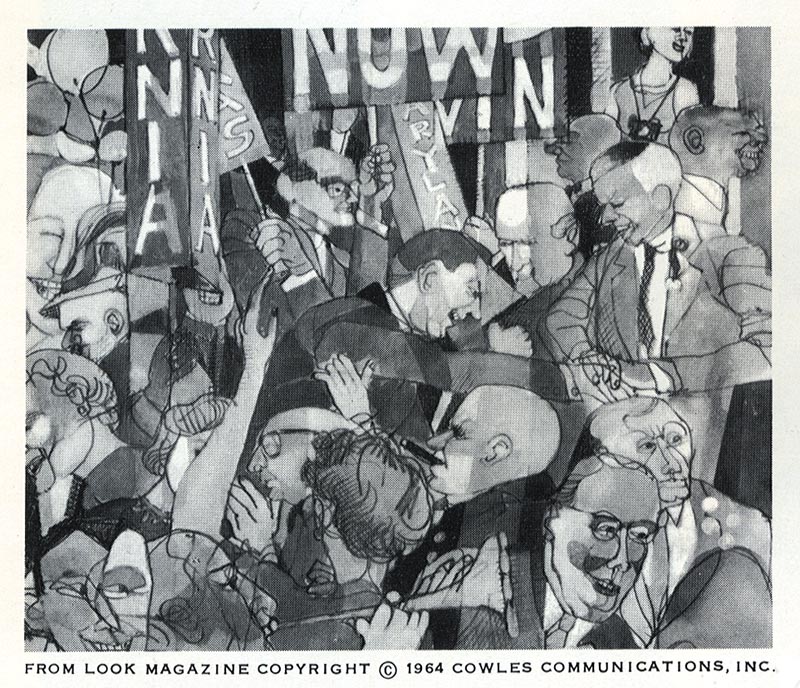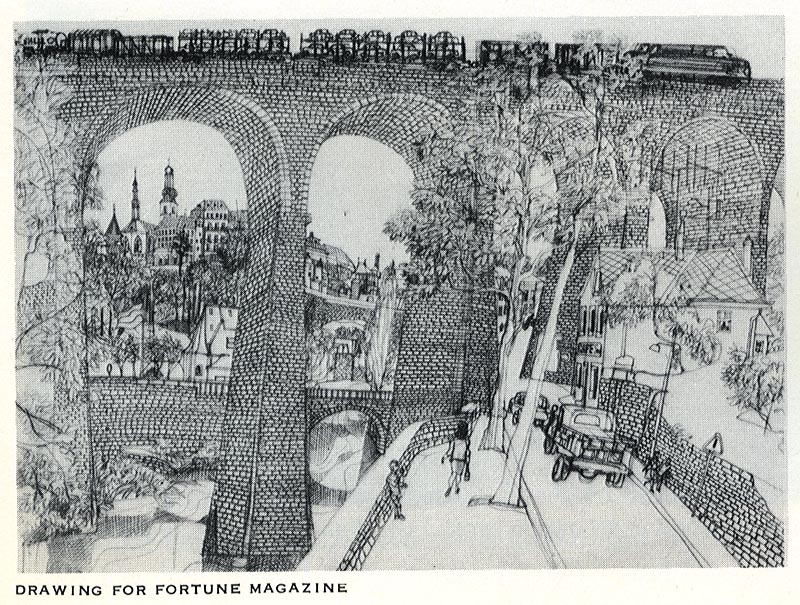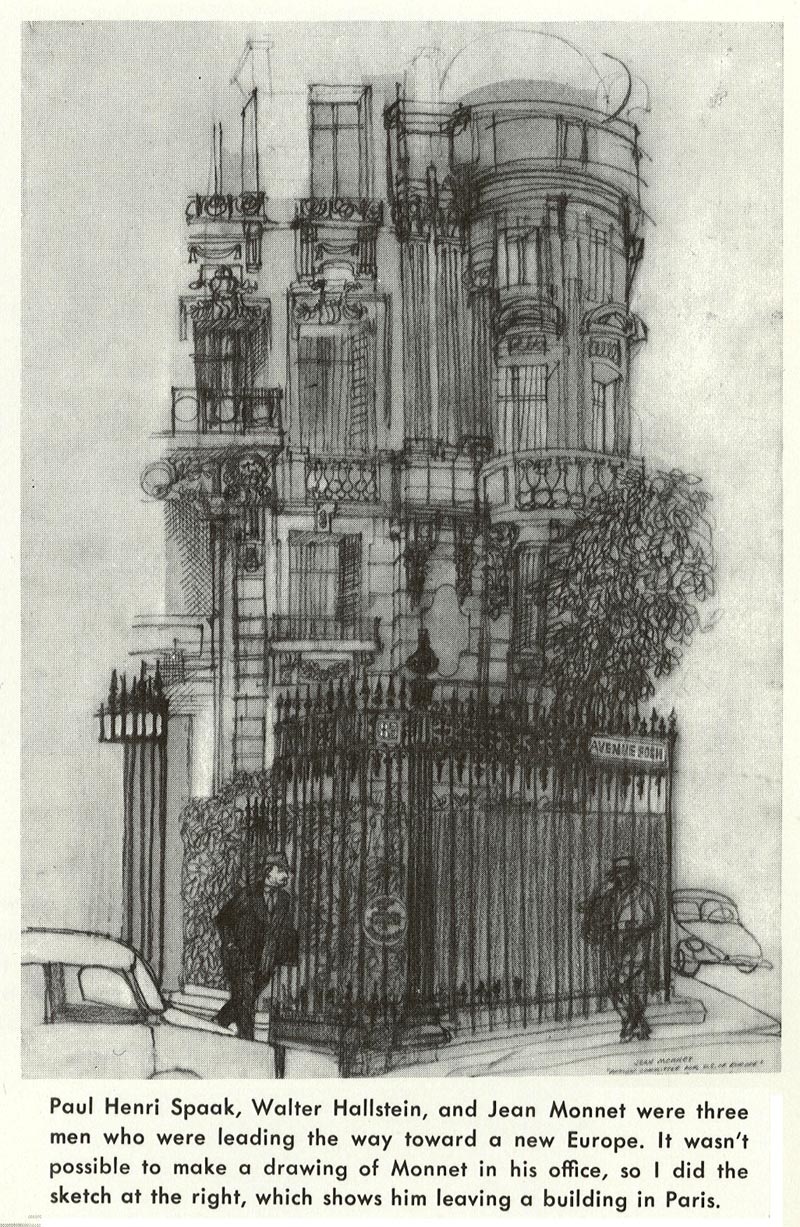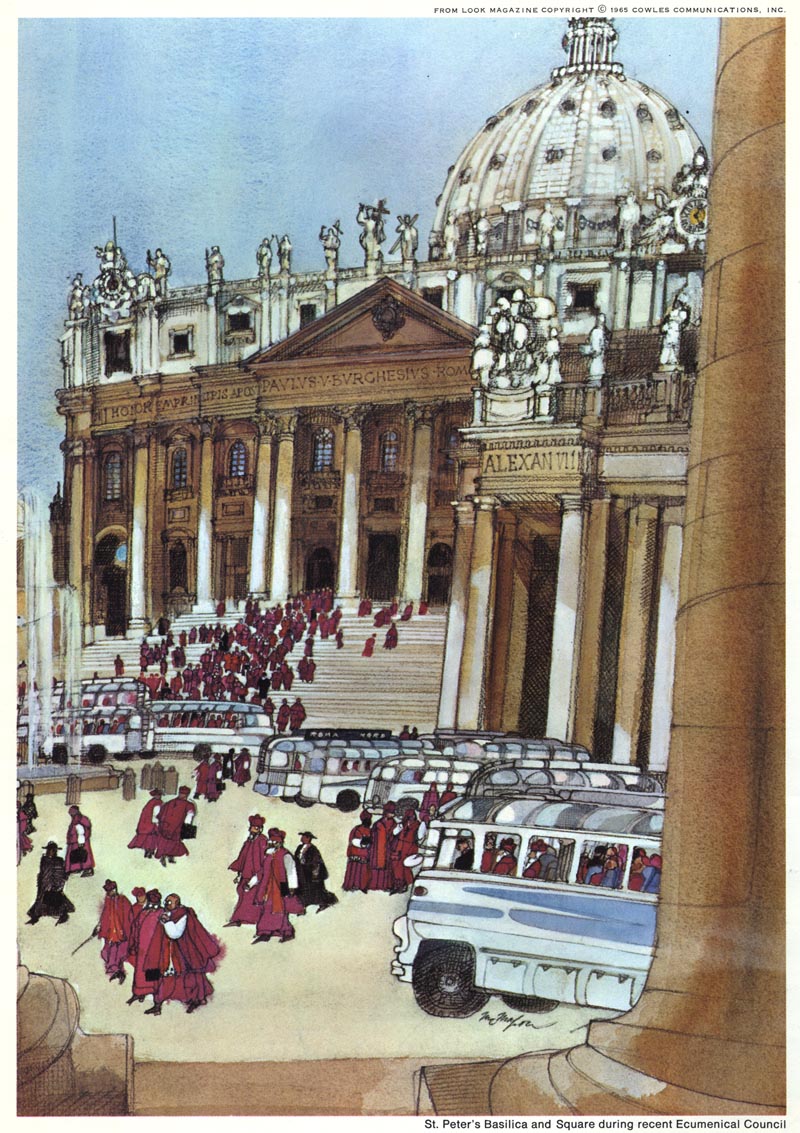
FAS: If you could make just one point about your philosophy of illustration, what would it be?
FM: I would say the important thing is that the artist should get out of the studio and look around. He should pick something that interests him. Your chance to interact with a subject increases then. It is my idea that the artist drawing directly at the site experiences an interaction with the subject and therefore extracts from the subject a kind of meaning that can be achieved in no other way.

FM: When photography became important the artist gave up and went back into the studio. It's time he got out. I also think that we are often too concerned with how a picture is done and not enough with what it has to say. The surface, the wash, light, dark, seem more important than what's in the picture. Technique is not so important as content.

FAS: Could you tell us a little bit about your work materials? Then we can dispense with technique for the rest of the interview.
FM: I work mostly in pencil, a Veriblack 315, which has a thick, soft graphite, and with charcoal pencil, which is just like an ordinary pencil except that it has a core of charcoal instead of graphite. I carry a bunch of these pencils in my pocket and I sharpen them with a razor blade. My paper comes in big white pads, 14 by 17 inches for small subjects like portraits and 22 by 30 inches for big scenes like the Cologne cathedral. You need a portable means of working. You wouldn't carry an easel out on my kind of job.

FAS: When you were showing your on-the-spot drawings to the instructors one of them commented, "That's a very aggressive size." What did he mean?
FM: Most guys do small sketches and then go back to the studio and work them up. I draw reproduction size when I go out. When you start a picture you don't know how it is going to evolve, although I don't have much time to change my mind when I'm out there. I like to work all over the paper. Most artists describe the work they do in the field as sketching. However, I draw. I often do the finished art on the site. I get choked up when i do sketches for future finishes. You begin to ask yourself, will the composition be right? Will the intersecting of this and that work? I draw the broad outlines on the spot and I see the picture then. If I don't finish the picture on the scene, I have at least the bones of it to be fleshed later. I prefer to be involved in the actual event. I think you gain from that. I may complete the details later, like drawing each individual brick.

FM: There's no shortcut or trick to this tedious job, but I do try to make every stroke count.
FAS: How can you do such precise architectural detailing and at the same time capture the action?
FM: For my Common Market story I made a drawing of Monnet coming out of the building, but I drew the building the day before. I had only a few seconds to catch Monnet himself.

FM: When I did the cardinals leaving St. Peter's I knew that St. Peter's would be there the next day so I could go back and do it. What I wanted to catch was the moment when they poured down the steps, and I did a sketch of the monument in the foreground while I waited for them to come out.

FAS: How long does it take you to do one of these on-the-spot drawings?
FM: it all depends on the subject. When I drew the Archbishop of Tokyo I made several quick sketches while he preached one sermon. It probably took no more than five minutes. My drawing of Catholic dignitaries meeting in St. Peter's took half a day.

FAS: Sometimes when you turn in a job you include notes on the subject matter of the sketches. How do you have time to research a story and make drawings too?
FM: I make notes right on the drawing paper when the subject says something that interests me. or, I make notes later so I won't forget. My wife is very helpful while I'm making a drawing. Sometimes she goes with me on trips. She can find out lots of things just by going around to shops, buying bread and cheese. I provide long-winded captions, full of details. I try to get the spirit of the scene into my words just as I try to do in my pictures. The editors then distill my story to fit the space.

* Continued tomorrow
* Many thanks to Matt Dicke, who provide all the material for today's post.
ReplyDeleteGood stuff. It's great to hear his views on art and find out the way he worked. I can relate because when I draw on location, I also bring a big board, charcoal pencils and a razor (although no graphite or a chair).
I'm looking forward to part 2. Thank you for posting this Leif (and Matt for sharing).
Each brick is an individual.
ReplyDeleteAs to the individual bricks after the set up of broadlines on the spot: "The bones are to be fleshed out later" to quote Mc Mahon.
Bones first, the flesh of detailed individual bricks later. But no brick look exactly the same, by McMahon's close observation. I digress - just wanted to say
Fabulous Stuff!
Just a great series of posts on Franklin McMahon. He was a wonderful artist and person. I invited Franklin as a guest speaker when I brought my master's class to Chicago many years ago. The class loved him and so did I.
ReplyDeleteThanks, Leif and Matt. McMahon was in a great tradition of on-the-spot sketch reporting, with Winslow Homer, Frederick Gruger, and Ogden Pleissner among his antecedents. Even Cornwell did some court reporting. The artist's hand gives the images a subjectivity and immediacy that goes beyond what the photojournalist can capture. The artist also has the advantage of being able to eliminate nonessentials and to combine elements and events that unfold over time.
ReplyDeleteJames-
ReplyDeleteWhat did Dean Cornwell's court reporting work look like?
Daniel, Cornwell covered the Lindberg kidnapping trial in 1935 with pencil drawings of various views of the courtroom, inside and out.
ReplyDeleteJames-
ReplyDeleteI found a link to one of the images:
http://images.ha.com/lf?set=path%5B6%2F2%2F3%2F5%2F6235419%5D%2Csizedata%5B450x2000%5D&call=url%5Bfile%3Aproduct.chain%5D
Good stuff. I had no idea he did that kind of work.
situs judi slot
ReplyDeletempo99
try this
ReplyDeleteB Best Hair Oil
kunkumadi face Oil
Wheat Grass Powder
Balu Herbals
UB-Slim caps
B-Care Dia Powder
Noni
https://crackpropc.com/faststone-capture-crack/
ReplyDeleteFastStone Capture Crack License Key editing tools include annotations (text, arrow lines, selections), resizing, cropping, sharpening, watermarking, applying side effects, and more. Other features include image scanning, global keyboard shortcuts, automatic file name creation, support for external editors, a color palette, a magnifying glass, a crosshair, and a screen ruler.
https://newcrack.org/mixpad-crack-registration-code-download/
ReplyDeleteCracked Here is a useful place where you can easily find Activators, Patch, Full version software Free Download, License key, serial key, keygen, Activation Key and Torrents.
good work is done here. thanks for sharing.
ReplyDeletevisit
visit
Nice blogs. Are you also searching for cheap nursing writing company? we are the best solution for you. We are best known for delivering quality essay writing services to students without having to break the bank
ReplyDeletehttps://cracklike.com/remote-computer-manager-crack-2/
ReplyDeleteRemote Computer Manager 6.2.0 Crack helps the computer network, including administration, work on computers, IP display.
I’m very happy to uncover this great site. I want to thank you for your time just for this fantastic read!! I definitely appreciated every little bit of it and I have you book-marked to look at new stuff on your site.
ReplyDeleteCCleaner Pro Crack
Transmac Crack
Matlab Crack
Cyberduck Crack